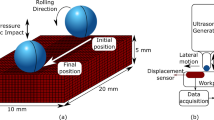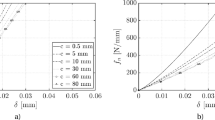Abstract
Surface contact fatigue is a major failure mode of many mechanical components, such as various gear pairs, bearings, cam-follower systems, and so on. The present study aims to develop a fatigue life prediction approach for finite line contact model using machined surface topography. Based on the developed model, the effect of working conditions and lubrication parameters on the lubrication performance and fatigue life are investigated. The obtained results show that, by introducing the realistic roughness, the distribution of pressure, film thickness and stress field is significant fluctuations. Meanwhile, the location of maximum stress tends to move to subsurface. The effect of load on fatigue life is significant. Yet, the speed does not seem to have a great influence on the fatigue life in various load ranges. It is also indicated that the high ambient viscosity is beneficial to the lubrication performance and fatigue life.
Similar content being viewed by others
References
Y. Z. Hu and D. Zhu, A full numerical solution to the mixed lubrication in point contacts, ASME Journal of Tribology, 122 (1) (2000) 1–9.
H. P. Evans, R. W. Snidle and K. J. Sharif, Deterministic mixed lubrication modelling using roughness measurements in gear applications, Tribology International, 42 (10) (2009) 1406–1417.
ISO, Calculation of load capacity of spur and helical gears, International Standards Organization, ISO-6336 (1997).
International Standards Organization (ISO), Rolling Bearings-Dynamic Load Ratings and Rating Life, Second Edition, ISO 281 (2007).
D. Dowson, A tribological day, Proceedings of the Institution of Mechanical Engineers, Part J: Journal of Engineering Tribology, 223 (3) (2009) 261–273.
Y. Q. Wang, H. Q. Li, J. W. Tong and P. R. Yang, Transient thermoelastohydrodynamic lubrication analysis of an involute spur gear, Tribology International, 37 (10) (2004) 773–782.
S. Li and A. Kahraman, A transient mixed elastohydrodynamic lubrication model for spur gear pairs, ASME Journal of Tribology, 132 (1) (2010) 1–9.
H. J. Liu, C. C. Zhu, Z. D. Sun and C. S. Song, Starved lubrication of a spur gear pair, Tribology International, 94 (5) (2016) 52–60.
R. Gohar and A. Cameron, The mapping of elastohydrodynamic contacts, Tribology Transactions, 10 (10) (1967) 215–225.
D. G. Wymer and A. Cameron, Elastohydrodynamic lubrication of a line contact, Proceedings of the Institution of Mechanical Engineers, Part J: Journal of Engineering Tribology, 188 (1974) 221–238.
H. Bahadoran and R. Gohar, Research note: end closure in elastohydrodynamic line contact, Journal of Mechanical Engineering Science, 16 (4) (1974) 276–278.
A. Mostofi and R. Gohar, Elastohydrodynamic lubrication of finite line contacts, ASME Journal of Tribology, 105 (4) (1983) 598–604.
S. Kuroda and K. Arai, Elastohydrodynamic lubrication between two rollers (Finite width analysis), Transactions of the Japan Society of Mechanical Engineers, 28 (241) (1985) 1367–1372.
Z. J. Wang, X. J. Shen, X. Y. Chen, Y. Zhou and T. S. Hua, Recent progress of elastohydrodynamic lubrication of finite line contacts, Tribology, 36 (1) (2016) 117–131.
H. P. Evans and R. W. Snidle, Film thinning factor for rollers of finite width under elastohydrodynamic conditions, Wear, 175 (94) (1994) 17–23.
S. Cretu, I. Bercea and N. Mitu, Dynamic analysis of tapered roller bearing under fully flooded conditions Part 1: theoretical formulation, Wear, 188 (1–2) (1995) 1–10.
X. Y. Chen, S. Q. Zhou and J. J. Ma, Oil film thickness and shape in Lundberg's profile roller contacts, Tribology Series, 32 (1997) 415–422.
M. Kushwaha and H. Rahnejat, Transient elastohydrodynamic lubrication of finite line conjunction of cam to follower concentrated contact, Journal of Physics D: Applied Physics, 35 (21) (2002) 2872–2890.
F. Arthur, F. Jean and B. Antoinette, Multilevel solution of the elastohydrodynamic contact for the water lubricated silicon carbide 3D line contact, Tribology Transactions, 45 (1) (2002) 110–116.
X. L. Liu and P. R. Yang, Analysis of the thermal elastohydrodynamic lubrication of a finite, Tribology International, 35 (3) (2002) 137–144.
X. L. Liu and P. R. Yang, Numerical analysis of the oilsupply condition in isothermal elastohydrodynamic lubrication of finite line contacts, Tribology Letters, 38 (2) (2010) 115–124.
P. Yang and P. R. Yang, Analysis on the thermal elastohydrodynamic lubrication of tapered rollers in opposite orientation, Tribology International, 40 (10–12) (2007) 1627–1637.
S. Li, A. Vaidyanathan and A. Kahraman, Influence of design parameters on mechanical power losses of helical gear pairs, Journal of Advanced Mechanical Design Systems, and Manufacturing, 3 (2) (2009) 146–158.
D. Zhu, J. X. Wang, N. Ren and Q. J. Wang, Mixed elastohydrodynamic lubrication in finite roller contacts involving realistic geometry and surface roughness, ASME Journal of Tribology, 134 (1) (2012) 97–104.
A. E. Serset and S. Akbarzadeh, Mixed-elastohydrodynamic analysis of helical gears using load-sharing concept, Proceedings of the Institution of Mechanical Engineers, Part J: Journal of Engineering Tribology, 228 (3) (2013) 320–331.
S. P. Chippa and M. Sarangi, On the dynamics of lubricated cylindrical roller bearings, part II: Linear and nonlinear vibration analysis, Tribology Transactions, 56 (6) (2013) 1097–1108.
H. L. Dong, J. B. Hu and X. Y. Li, Temperature analysis of involute gear based on mixed elastohydrodynamic lubrication theory considering tribo-dynamic behaviors, ASME Journal of Tribology, 136 (2) (2014) 325–325.
H. U. Jamali, K. J. Sharif, H. P. Evans and R. W. Snidle, The transient effects of profile modification on elastohydrodynamic oil films in helical gears, Tribology Transactions, 58 (1) (2015) 119–130.
M. Y. Liu, C. C. Zhu, H. J. Liu, H. F. Ding and Z. D. Sun, Effects of working conditions on TEHL performance of a helical gear pair with non-Newtonian fluids, ASME Journal of Tribology, 136 (2) (2014) 021502.
M. Y. Liu, C. C. Zhu and H. J. Liu, A micro-TEHL finite line contact model for a helical gear pair, Advances in Mechanical Engineering, 7 (1) (2014) 104790.
M. Y. Liu, C. C. Zhu, H. J. Liu and C. H. Wu, Parametric studies of lubrication performance of a helical gear pair with non-Newtonian fluids, Journal of Mechanical Science and Technology, 30 (1) (2016) 317–326.
R. Beilicke, L. Bobach and D. Bartel, Transient thermal elastohydrodynamic simulation of a DLC coated helical gear pair considering limiting shear stress behavior of the lubricant, Tribology International, 97 (2016) 136–150.
B. Wei, J. X. Wang, G. W. Zhou, R. S. Yang, H. J. Zhou and T. He, Mixed lubrication analysis of modified cycloidal gear used in the RV reducer, Proceedings of the Institution of Mechanical Engineers, Part J: Journal of Engineering Tribology, 230 (2) (2016) 121–134.
A. Torabi, S. Akbarzadeh and M. R. Salimpour, Mixed thermo elastohydrodynamic lubrication analysis of finite length cam and follower mechanism, Journal of Mechanical Science and Technology, 30 (3) (2016) 1295–1303.
D. Zhu, N. Ren and Q. J. Wang, Pitting life prediction based on a 3-D line contact mixed EHL analysis and subsur face von mises stress calculation, ASME Journal of Tribology, 131 (4) (2009) 1–8.
K. L. Johnson, Contact Mechanics, Cambridge University Press, Cambridge, UK (1985).
S. B. Liu and Q. Wang, Studying contact stress fields caused by surface tractions with a discrete convolution and fast fourier transform algorithm, ASME Journal of Tribology, 124 (1) (2002) 36–45.
Author information
Authors and Affiliations
Corresponding author
Additional information
Recommended by Associate Editor In-Ha Sung
Mingyong Liu, born in 1985, obtained Ph.D. degree in the Chongqing University, China in 2013. His research fields include gear dynamic and gear tribology. He had published 6 international journal papers and 3 conference papers in international gear conferences.
Rights and permissions
About this article
Cite this article
Liu, M., Wu, C. & Yan, C. Predicting fatigue life for finite roller contacts based on a mixed EHL model using realistic surface roughness. J Mech Sci Technol 31, 3419–3428 (2017). https://doi.org/10.1007/s12206-017-0630-2
Received:
Revised:
Accepted:
Published:
Issue Date:
DOI: https://doi.org/10.1007/s12206-017-0630-2




